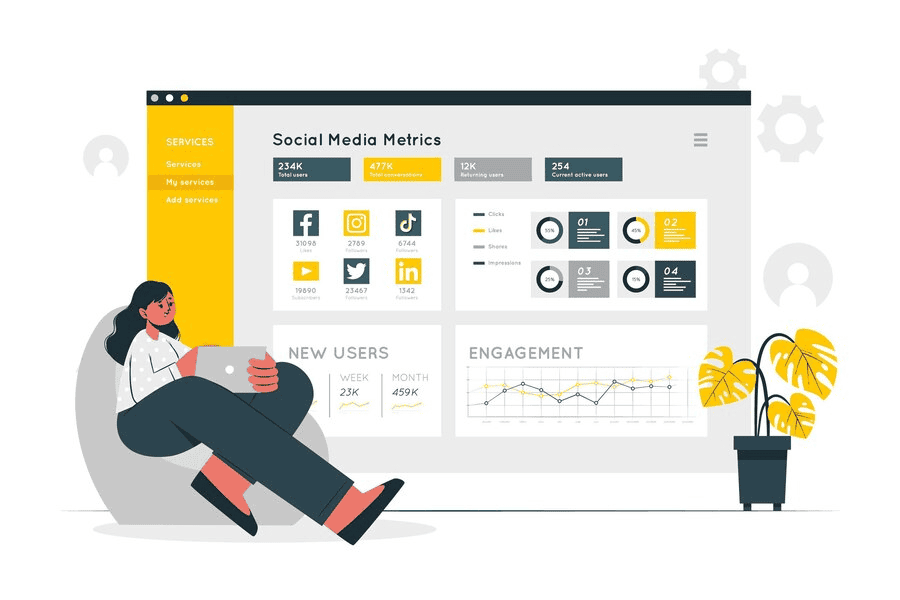Not all social media followers are equal. While passive followers may boost your impressions, engaged leads are the ones who truly matter—they interact, show interest, and are more likely to convert.
Understanding the difference between engaged leads and passive followers is crucial for building a results-driven social media presence.
In this guide, we’ll explore what makes an engaged social media lead. We’ll also see how to transform passive followers into active participants who drive meaningful results.
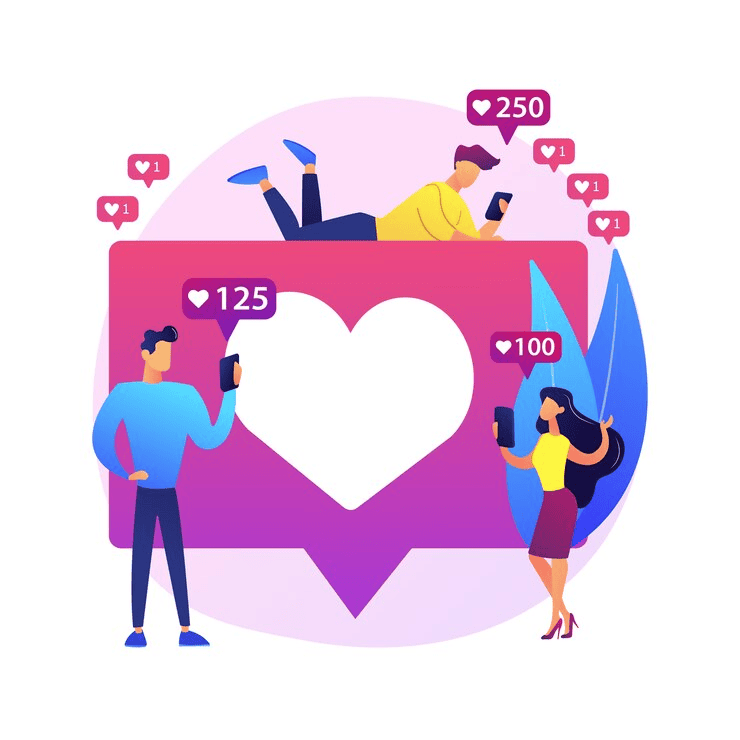
Image by vectorjuice on Freepik
What is Social Media Engagement?
Social media engagement refers to users’ interactions with your content, such as likes, comments, shares, clicks, and more. These interactions signify interest, connection, and the potential to convert followers into customers. Engagement shows that your content connects with your audience and but also serves a much bigger purpose.
With the latest algorithm changes, organic reach has dropped on almost every social media platform. However, accounts with higher social media engagement are less impacted.
Platforms like Facebook, Instagram, and LinkedIn prioritize posts that encourage “meaningful interactions” as key indicators of relevance. For example, Facebook boosts content with active comments, Instagram rewards frequent saves and shares, and LinkedIn highlights posts with thoughtful discussions and reactions.
Timely engagement demonstrates that your content resonates with your audience and offers several key benefits:
- Boost Visibility: Algorithms favor engaging content, expanding your reach.
- Build Trust: Interactions strengthen connections with your brand.
- Drive Conversions: Engaged users are more likely to take action, such as clicking links or making purchases.
How to Boost Social Media Engagement
Social media without engagement is merely noise in a crowded room.
Let’s go over eight essential tips for boosting your social media engagement and keeping it up.
Post Engaging Content
The starting point is your social media content. Your content needs to resonate with your audience and the general tone on each social media platform. There’s really no one size fits all!
We spoke to a couple of entrepreneurs about the content that drives the most engagement for them.
Draven McConville, a tech entrepreneur and investor, says, “Focus your efforts on solving real industry problems and engaging authentically with your audience. Valuable insights and engagement with your audience will always outperform pushy sales tactics.”
At the same time, Russell Gous from the money transfer comparison website MoneyTransfer.com.au shares, “We’ve found that customer stories and insights—in our case, about transferring money—help build meaningful connections that naturally convert into leads.”
Encourage Two-Way Communication
Engaged social media leads are those who actively interact with your posts, ask questions, and contribute to conversations. To grow your social media engagement, encourage two-way communication. By building a community that feels heard and valued, your brand can drive stronger connections and ultimately increase conversions.
Ask questions, conduct polls, and incentivize your audience to share their opinions. Here’s an example from Canva, engaging users with polls on design-related topics.

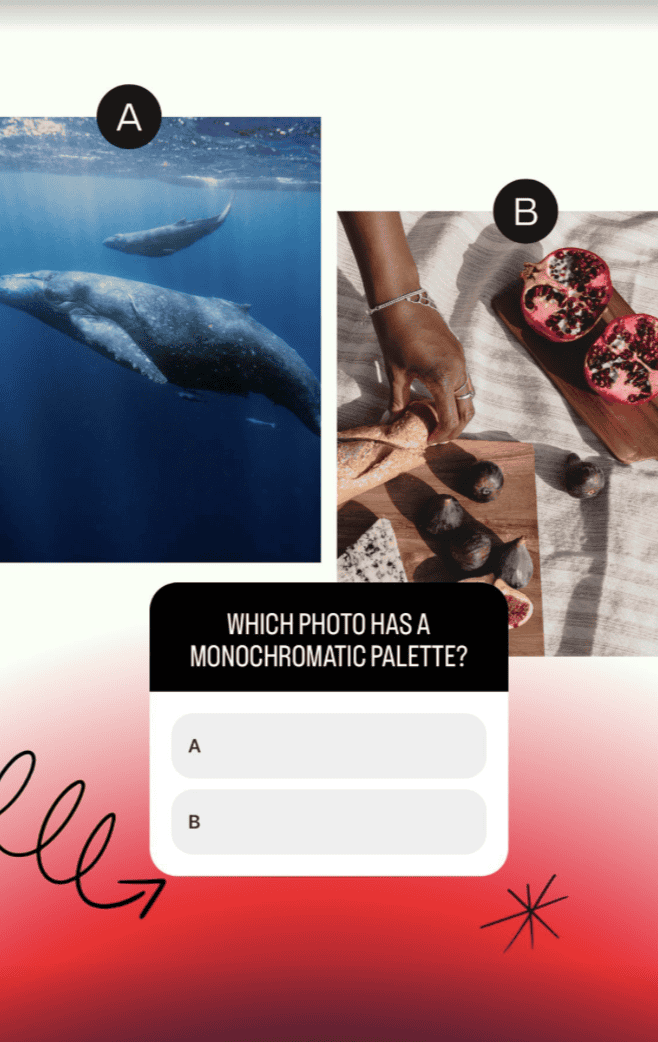
Another idea is to host interactive sessions, such as Q&As or live streams, to create real-time engagement.
Maintain a Consistent and Authentic Voice
Consistency breeds familiarity. Develop a brand voice that aligns with your values and resonates with your target audience. Whether playful or professional, stay true to your identity.
An authentic brand voice humanizes your brand, fostering meaningful connections and positive conversations.
Establish clear guidelines that outline tone, character, and language to maintain this authenticity, especially if multiple people manage your accounts.
A unified approach avoids confusion while allowing room for personal touches, like signing off messages with a name, to keep interactions relatable.
Tailor your communication style to suit your audience. For instance, humor might resonate with one group, while a more formal tone might appeal to another.
Enhance your content with GIFs, emojis, or other visual elements to convey emotion and personality, making your brand voice consistent, engaging, and memorable.
Use Compelling Visuals
High-quality visuals capture attention and make your content memorable. Experiment with formats like carousel posts, short videos, and vibrant infographics to keep your feed fresh.
For example, The Merriam-Webster dictionary uses a combination of illustrative images and videos with fun captions to engage Instagram users.
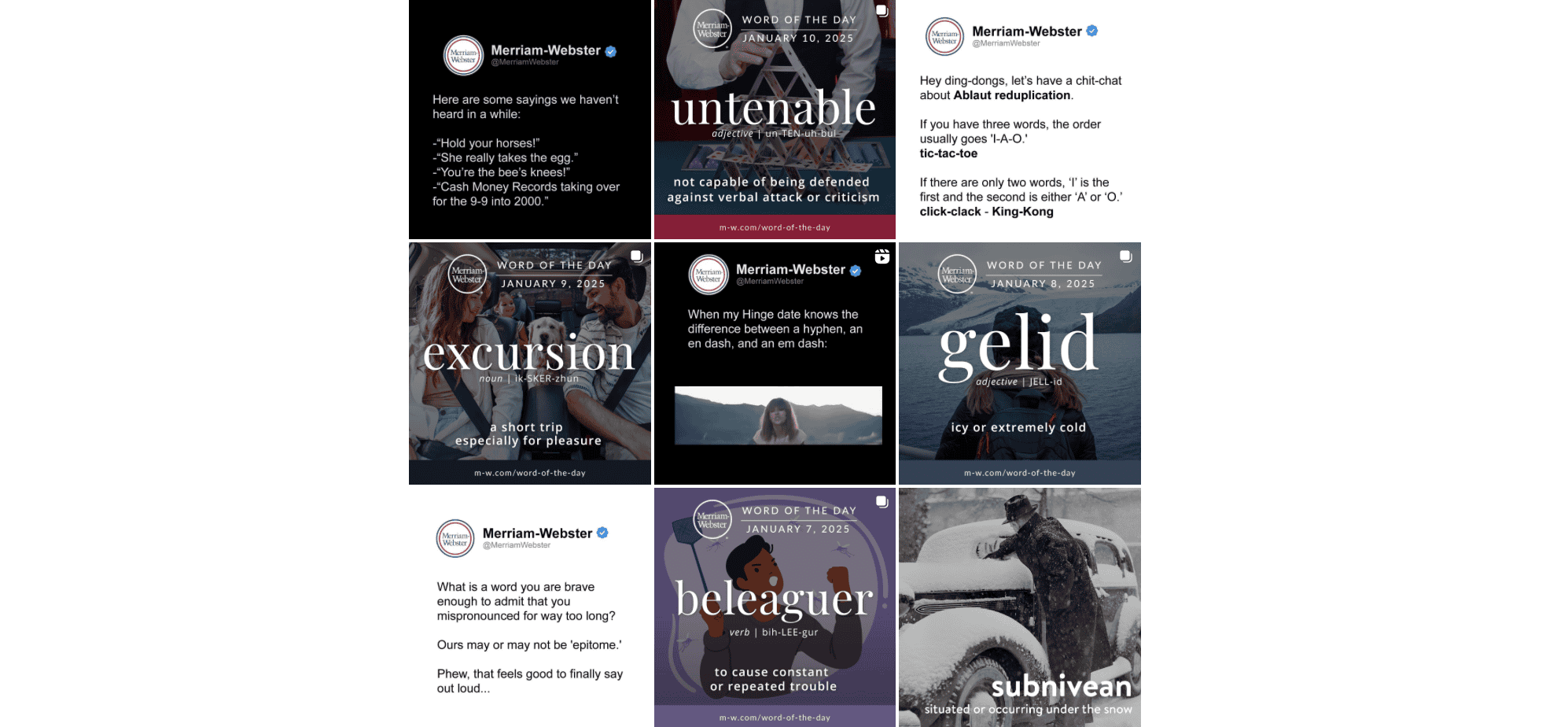
Creating quality images and videos can be time-consuming and the costs quickly add up. As a solution, explore opportunities to create visuals with AI and re-purpose existing content into various formats.
Repurpose Content
Repurposing content involves transforming existing materials into new formats for different platforms. It allows you to “review” your top posts for new engagement, or take your best performing content from one marketing channel to another. You’re broadening the reach of your content while saving valuable time and resources.
When it comes to repurposing, you have a wide range of options. For example, you can:
- Break down long blog posts into smaller, digestible snippets for social media platforms.
- Edit recordings of webinars into shorter, more engaging videos for YouTube or social media.
- Repurpose social media content into newsletters to support your email marketing campaigns and drive higher engagement across platforms.
- Put underperforming social media posts into another format.
- Re-create your most successful content to get new engagement.
Leverage User-Generated Content
Encourage your audience to create content featuring your brand – online reviews, video testimonials, photos of your products, and more. When you share content created by users, you build credibility and a sense of community.
Here’s how you can incentivize users to share UGC.
GoPro invites users to submit their videos and photos to win cash prizes and a chance to be featured on GoPro’s official channels. These themed challenges, like the Photo of the Day or #GoProSnow Challenge, generate significant engagement and thousands of impressions.
User-generated content makes up a big portion of GoPro’s marketing materials, driving engagement, organic growth, and enhancing brand visibility.
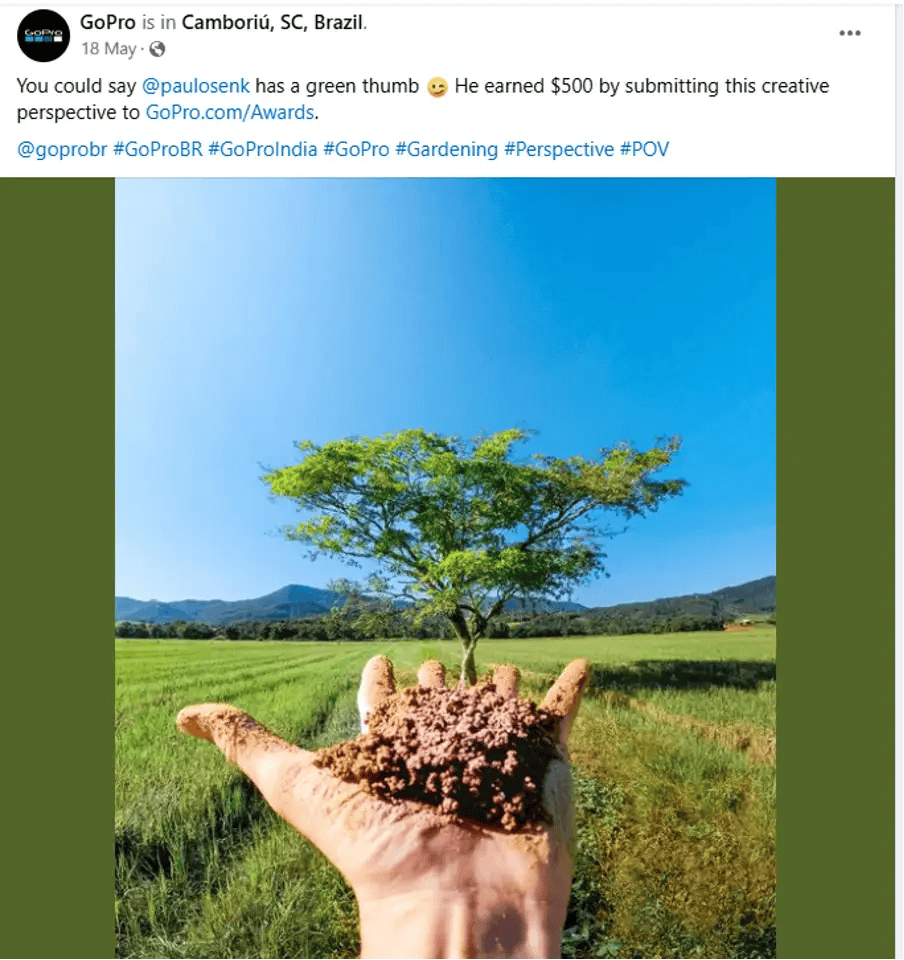
If you have an office or retail locations, you can display UGC on a smart TV using digital signage. This increases visibility for your content and encourages more customers to follow you online and tag your brand in their posts.
Add Calls-to-Action
CTAs are vital for driving user actions. They are more than just buttons or links—they serve as a roadmap for your followers to follow through on their interests.
CTAs come in various forms, each suitable for different engagement levels and objectives. Let’s break down some of the most effective types:
- Direct CTAs: These ask the audience to complete a task. Examples include “Buy Now,” “Download our free guide,” or “Register for the webinar.” These CTAs are highly effective when your goal is to push for a quick conversion.
- Interactive CTAs: A more engaging approach, these encourage participation. Examples like “Vote in our poll,” “Answer this question,” or “Tag a friend who needs to see this” can significantly boost user interaction. Interactive CTAs are particularly powerful for creating a two-way conversation with your followers, fostering a deeper connection.
- Value-Driven CTAs: Instead of merely asking for a transaction or action, these focus on the value the user will receive. Phrases like “Get your free eBook,” “Start your free trial,” or “Get your free consultation” give your followers a reason to act based on what they will gain from taking action.
The placement of your CTAs is just as crucial as their content. Position your CTAs where your audience is likely to be most engaged and ready to take the next step.
- End of carousel posts: A CTA can nudge users to drive the desired action at the end of a carousel that has delivered value or piqued curiosity.
- Captions: You can add a CTA in the caption text and use emojis to draw attention to it. For example, “Tap the link in bio to get started” can seamlessly guide your followers to the next step.
- Interactive Buttons: Social media platforms such as Instagram and Facebook offer interactive buttons (like “Swipe Up” or “Shop Now”) within Stories or videos. These CTAs are highly effective in prompting immediate action, especially for mobile users.
Host In-Person Events
Hosting in-person events is a powerful way to foster deeper connections with your audience. Live interactions foster genuine connections, increasing audience loyalty and driving engagement long after the event ends.
In-person events provide unique, shareable experiences that naturally encourage social media activity. Attendees often post photos of the venue, videos, and live updates, tagging the brand and using event-specific hashtags, which amplifies reach.
These events also generate exclusive behind-the-scenes content that brands can share across platforms, creating FOMO (fear of missing out) among non-attendees.
While in-person events are a great marketing tool, logistics can be challenging. Choosing a comfortable venue in an easily accessible location is key. Plan a cloakroom service or a self-storage option. Taste test the catering in advance and make sure there is enough food and beverages. On the day of the event, arrive early for a technical check-up and other finishing touches.
Factors Impacting Engagement
Getting social media engagement is not all about what you post. It’s also about taking advantage of the differences between social media platforms and posting when your audience is most active.
Social Media Algorithms
Every social media channel is unique. Understanding what drives engagement in each platform and how their algorithms work will help you gain engaged social media leads.
Social media algorithms determine what content users see, prioritizing engagement and relevance. Platforms favor posts that draw attention and spark interactions. Early interactions can amplify reach, so ensure your posts captivate attention within the first hour of publishing.
Each platform has unique algorithms and audience behaviors, and your strategy has to reflect these differences. Understanding each platform’s unique strengths ensures your content reaches and engages the right audience effectively.
For example:
- Instagram: Focus on visually appealing content. Use high-quality images and videos, and experiment with different formats such as carousel posts, Reels, and Stories. Use interactive stickers like polls and quizzes. Include hashtags to boost discoverability.
- LinkedIn: focus on sharing industry insights, achievements, and helpful tips to establish expertise and engage your network. Use different formats such as text, video, carousel, or image posts.
- TikTok: Embrace creativity with short, entertaining videos. Use trending sounds and participate in challenges to gain visibility.
- Facebook: Mix up promotional updates, with customer testimonials, behind-the-scenes looks at company operations, and interactive posts like contests. Use diverse content formats and provide timely replies to comments and messages.
- Twitter: Keep it concise and timely. Short updates, news, and active participation in trending topics with hashtags perform best.
- YouTube: Focus on video quality and consistency. Use engaging thumbnails and interact with your audience through comments to build community. Creating YouTube Shorts is a great way to reach new viewers and grow your audience.
Posting Times
Timing your posts strategically ensures your content reaches the right audience when they’re most active.  Image by vectorjuice on Freepik
Image by vectorjuice on Freepik
Strategic post timing can impact your social media engagement. While there’s no universal “best” time to post, analyzing your audience’s activity patterns is key. Use insights from your social media analytics to schedule posts when your followers are most active.
Here are the timeframes that align with general user activity patterns:
- Facebook: Weekday mornings are optimal, with peak engagement around 10 a.m. on Fridays.
- Instagram: Weekdays between 10 a.m. and 2 p.m. are ideal, particularly on Tuesdays and Wednesdays when engagement extends until 4 p.m.
- LinkedIn: Professional audiences are most active during weekday mornings, especially between 7 a.m. and 9 a.m.
- Twitter: Posting between 10 a.m. and 1 p.m. on Mondays and Tuesdays yields higher engagement.
- TikTok: Afternoon posts perform well, with Thursdays at 3 p.m. being particularly effective.
Use Bulkly to schedule your posts ahead of time, ensuring a consistent flow of engaging content that aligns with your audience’s peak engagement times.
Keep Monitoring Engagement Metrics
Monitoring social media metrics provides valuable insights into how audiences engage with content. They guide businesses in improving audience experiences, optimizing efforts, and eliminating ineffective approaches, ultimately saving time and resources.
Key Metrics to Track
- Engagement Rate: Measures overall interaction relative to your audience size.
- Click-Through Rate (CTR): Tracks how effectively your content drives traffic.
- Comments vs. Likes: Comments often signal deeper engagement.
Analyze Engagement Rates
Leverage analytics tools to identify trends and refine your strategy. Benchmark your performance against industry standards to set realistic goals.
Analyze which social media actions drive the most traffic and conversions, such as clicks leading to sign-ups for email marketing campaigns.
Bulkly can streamline the process by providing insights into your most engaging posts.
Evaluate Audience Growth
The real value lies in attracting quality leads who actively engage with your content, share their insights, and ultimately become loyal supporters. These engaged followers resonate with your brand message and are far more likely to convert into paying customers. They’re a much more valuable asset than a large number of passive, disengaged followers.
Simply put, an increase in follower count without the corresponding engagement doesn’t equate to meaningful growth.
This group of active followers will advocate for your brand and be more willing to act on your CTAs, whether it’s making a purchase, signing up for a newsletter, or sharing your content with others.
FAQ
- What is the 5 5 5 social media strategy?
The 5-5-5 Strategy revolves around three core engagement actions that guide your social media efforts. It can be as simple as engaging with 5 new people, commenting on 5 posts, and replying to 5 comments daily to boost visibility.
- How do you keep leads engaged?
To keep leads engaged on social media, you need consistent brand presence, high-value content, and authentic interaction.
- What is considered engagement on social media?
Engagement includes authentic interactions with your social media content, such as likes, comments, shares, saves, and clicks. It measures how people interact with your social media channels.


